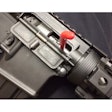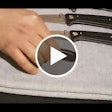I've been using frangible ammunition exclusively at Valhalla for almost four years now. We've been through several different brands and experienced some interesting results along the way. Let me share some of them with you.
First, let's discuss the benefits of frangible ammo.
Valhalla's 360-degree shooting areas present some unusual problems associated with our goal of putting students in the most realistic shooting environment possible and our need to make sure that they are reasonably safe
We realized very quickly that we didn't want to go to the trouble to put in reactive and interactive targets, 3D mannequins, furniture, props, painted walls, carpeting, special effects lighting, and sound and then have all the shots be taken into large, unwieldy and painfully obvious "shooting range like" bullet traps. That would have amounted to a huge waste of effort.
Frangible ammunition made it possible for us to make the bullet traps much more a part of the environment by allowing them to be made of mild one-quarter-inch steel, instead of a special hardened steel or some thick rubber block material. By facing the traps with half-inch thick rubber and leaving a gap between the rubber and the steel, we had a trap that was relatively light and thin enough to be painted and placed in the areas that we would be shooting without compromising the reality of the settings. While this type of trap will not stop rifle rounds—frangible or not—it does a great job with frangible pistol bullets from a variety of manufacturers.
Of course, our 360 ranges themselves are steel boxes designed to keep rounds inside regardless of what they hit on the way to the outer walls, but we didn't want to be forced to repair the interior walls constantly, so these unobtrusive bullet traps are placed throughout the interior in the areas most often shot into.
Placing these traps throughout a maze of plywood rooms means that there is a lot of steel to be hit at a lot of odd angles. Shooting lead rounds in this environment could be deadly. But shooting frangible rounds is about as safe as any live fire environment can be. Quality, unjacketed frangible bullets do not allow fragments of any significant mass to ricochet off of these steel surfaces. Although the small, lightweight particles are moving very fast off of the steel they strike, they do not carry much momentum.
It is important to note that I am speaking strictly about unjacketed frangible ammunition. The jacketed versions of frangible ammunition do not increase the safety for close range engagement of steel targets significantly enough to warrant their use. The jacket itself can maintain significant energy after coming off of a hard surface that it poses a danger to shooters and instructors in the area.
The availability of non-toxic unjacketed frangible ammo made our ranges even safer and cleaner. But they are not perfect.
When we first started shooting this ammo, which has heavy-metal free primers, there were some problems. Two brands of ammunition with these special primers caused a significant amount of damage to several guns. After only a few hundred rounds, the breech faces were being damaged to the point that the strikers/firing pins were being affected.
This happened to every gun that we used, including 1911s, Glocks, and Berettas. Luckily, the ammo companies involved acknowledged the problem, fixed it on their end, and paid for the repairs to the guns, replacing the slides in most cases. The problem was solved by opening the flash hole and creating less back pressure on the "hard" heavy metal free primers, which were damaging the breech faces.
The other problem with these hard primers is that there is a relatively high failure rate — more than 10 percent in revolvers, especially in small revolvers. There apparently just isn't enough force being applied by the springs in these guns to initiate the non-toxic primers, which are much less sensitive than their traditional counterparts. This, again, has been seen from more than one manufacturer.
The fact is that frangible ammo isn't the best training choice for revolvers anyway, as the jump through the forcing cone often cracks the rounds, and you're as likely to see multiple holes in your target as you are to see one.
From a training standpoint, however, frangible rounds can help marginal shooters improve their form and recoil control. They are significantly lighter than typical lead rounds for any given caliber and the ones loaded for training purposes obviously put out much lower energies than typical defensive or duty ammunition. This means that there is less force acting on the firearm during the shooting process. A great byproduct of this is the betrayal of any flaws in the shooter's platform or the reliability of a semi-automatic pistol.
It is much more common to see unsupported platform (sometimes called "limp wrist") failures with this lighter ammunition than with "hot loads," which blow the gun into operation. Many experienced shooters have been frustrated with this fact when the rounds reveal a weakness in their technique.
Of course, after they correct their problems and are able to control recoil better, they end up being faster shooters with their full-power loads, and they appreciate the learning opportunity provided by the lightweight frangible rounds.
Most indoor ranges are required to have sophisticated filtration systems to capture the toxic substances released into the air during shooting. With non-toxic frangible ammunition, this is not necessary. It is important to note, however, that many traditional steel bullet traps will produce a considerable amount of non-toxic dust when used with frangible ammunition. This dust can become uncomfortable to work and train in if you don't have adequate containment and exhaust systems in place.
The square range at Valhalla, for example, was originally designed to trap the Win-Clean reduced-lead-hazard rounds, not frangible. It took a couple of tries and a vastly increased exhaust capacity (with less filtration) to control the dust problem created by these rounds striking steel at the back of the range. Currently, we are using a high-rate exhaust system combined with dense rubber blocks at the backstop to control the dust, and it works very well.
Overall, non-toxic frangible pistol ammunition is a great asset to close-quarters, reality-based firearms training. But understanding the limitations and requirements of these specialty rounds is an important part of employing them successfully.


















